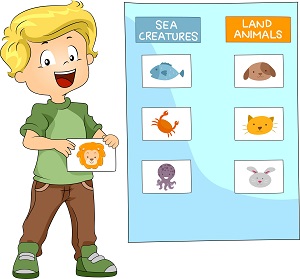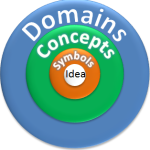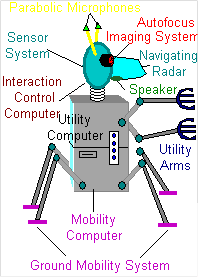26 May AI Domains and Approaches
 Grouping, Classifying and Categorizing
Grouping, Classifying and Categorizing
How do you solve big technical problems? Rather than selecting or inventing an approach and then attempting to apply it to a problem to see how well it works, let’s analyze the problem and see if we can find or invent a solution that matches the problem space, and see if that works. Or you could come at it from both directions and see if the search converges in the middle.
The word domain, in this context, applies to a grouping of conceptually related things. In the case of automatable activities or problems, we try to categorize them based on similarities that may require similar automation techniques. Instead of speaking in terms of problems individually, it is often useful to group problems whose solutions may have things in common. Grouping problems into categories or domains lets problem solvers expand their perspectives a bit, often enabling them to develop solutions that can be used for many problems that share knowledge structure or process characteristics.
| Understanding Context Cross-Reference |
|---|
| Click on these Links to other posts and glossary/bibliography references |
|
|
|
| Prior Post | Next Post |
| What Constitutes a Brain | Machine Components for Intelligence |
| Definitions | References |
| conceptual domain | Winston 1984 |
| knowledge context association | Elman 1988 McMillan 2012 |
| automata process modeling | Sprague 1986 |
 Elman 1988 is an example of a combination or bi-directional approach: Using the approach of connectionist networks, try to solve problems associated with a temporal processing domain, and if needed, adapt the approach to support the domain. Sprague 1986 also describes a bi-directional strategy in that the expert system approach can use adaptable models that can be tailored to the problem space.
Elman 1988 is an example of a combination or bi-directional approach: Using the approach of connectionist networks, try to solve problems associated with a temporal processing domain, and if needed, adapt the approach to support the domain. Sprague 1986 also describes a bi-directional strategy in that the expert system approach can use adaptable models that can be tailored to the problem space.
PROBLEM DOMAINS FOR MIPUS
In MIPUS’s cognitive apparatus, there are many different functions that his designers wanted to install. The functions required solving problems in many domains:
- Vision (to see dishes and obstacles)
- Autonomous Navigation (to avoid obstacles)
- Grasping and Lifting (to clear the table)
- Predictive Analysis (when to clear dishes)
- Decision Making (how much to carry at once)
- Explanation (for when MIPUS errs)
- Language (to speak explanations and interpret commands)
 Each of these domains is fundamentally different, with different input, triggers, processes and outputs, But within each of these domains, there may be many different tasks that are important to MIPUS’ success in performing well and achieving desirable outcomes. Each of these domains may bring to mind different examples of hardware or software we have encountered, that performs well at this type of tasks. It is sometimes possible to find a solution technique that fits neatly into a domain. Sometimes, however, there are a few choices, and sometimes there are none. The onus on the problem solver is to weigh the options and choose well.
Each of these domains is fundamentally different, with different input, triggers, processes and outputs, But within each of these domains, there may be many different tasks that are important to MIPUS’ success in performing well and achieving desirable outcomes. Each of these domains may bring to mind different examples of hardware or software we have encountered, that performs well at this type of tasks. It is sometimes possible to find a solution technique that fits neatly into a domain. Sometimes, however, there are a few choices, and sometimes there are none. The onus on the problem solver is to weigh the options and choose well.
In the domain of natural language processing, there is still a raging debate about the relative appropriateness of “statistical” approaches and “meaning-based” approaches. I see no reason why we can’t use both.
Model Components
Achieving a computer model that displays some functional properties of a biological brain could mean we need to design computer hardware that is better than the computers now available. It is possible, however, that adequate hardware already exists; in that case, perhaps we could simply program existing hardware so it would run in a more brain-like manner. Some researchers have already concluded that digital computers are not good models for the brain. Those who adhere to this school of thought believe we need to improve analog computing, return to the drawing board or accept the idea that computers and brains are totally dissimilar.
The first three sections of Understanding Context consider human information-processing hardware. In later volumes, we compare this to computational hardware, also known as Information System Components and Characteristics. There are seven components to consider. The first three are listed here; the other four follow on the next page.
1. A processing mechanism capable of interpretation, responsiveness, introspection, creativity, problem solving, self-sustenance, and other complex processes.
2. Input and Output channels that are able to process multi-source/media input and output.
3. Short-term data storage capable of storing large quantities of new information.
The first three components of computation, shown at right, are essential for any data-processing system. Note that some of the capabilities described for a processing mechanism (#1) apply solely to the human brain.
More Components
Information System Components and Characteristics (continued)
4. Long-term data storage capable of overcoming damage/loss of part of memory with minimal degradation.
5. Links between parallel processing elements that permit the parallel processing of multiple inputs and generate multiple outputs.
Long-term data storage (#4), present in the brain and in most computers, is necessary to make the system ultimately useful. Links between parallel processing elements (#5) are specific to parallel computer architectures.
In addition to the hardware components introduced in the first five items, the following software-like mechanisms for information processing could be basic building blocks for Artificial Intelligence computing systems:
6. A learning mechanism capable of integrating new information into long-term storage.
7. An association mechanism capable of creating logical links between new information and known information and new links between bits of known information.
The new mechanisms listed here (#6 and #7) are parts of human cognition, although they are not fully understood. Some of the basic assumptions underlying present research are embodied in the seven selected components introduced here and on the previous page. There are many AI domains and approaches that are well-matched to those domains. I will work to lay those out over the next few weeks as I continue to explore a better basis for understanding context.
| Click below to look in each Understanding Context section |
|---|








